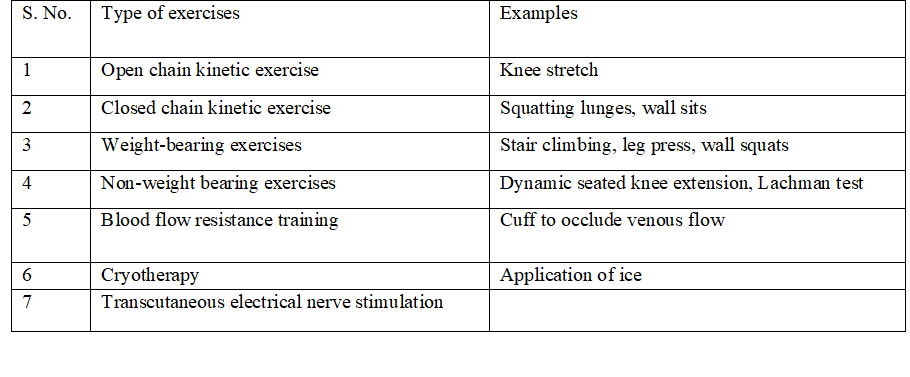Postoperative Rehabilitation of Anterior Cruciate Ligament Reconstruction
Abstract
Anterior cruciate ligament injury is commonly seen in sports related trauma. Complete tear requires surgical reconstruction. During postoperative rehabilitation, because of arthrogenic muscle inhibition (AMI), the quadriceps muscle remains inactive and has reduced contraction. Various strategies were aimed at treating this AMI and/or improve quadriceps strength such as open chain (OKC) and closed chain kinetic (CKC) exercises, blood flow resistance training (BFRT), cryotherapy, and transcutaneous nerve stimulation (TENS). Of all these, CKC was better than OKC in improving the range of movements, weight bearing exercises provided quicker return to physical activity. Cryotherapy was found to be an effective way to counter AMI and improve knee function and reduce the pain. The BFRT and TENS were found to be ineffective. Single legged hop test at six months postoperatively was found to be reliable predictor of the quadriceps function at one year. Electromechanical dynamometry is the gold standard machine to assess the knee extension and provide exercise, handheld dynamometry is easy to use. Leg press, leg extension machine are other machines used to provide exercises.
References
Perry BD, Levinger P, Morris HG, Petersen AC, Garnham AP, Levinger I, et al. The effects of knee injury on skeletal muscle function, Na+, K+-ATPase content, and isoform abundance. Physiol Rep 2015;3:1–14. https://doi.org/10.14814/phy2.12294.
Hart JM, Kuenze CM, Diduch DR, Ingersoll CD. Quadriceps muscle function after rehabilitation with cryotherapy in patients with anterior cruciate ligament reconstruction. J Athl Train 2014;49:733–9. https://doi.org/10.4085/1062-6050-49.3.39.
Uçar M, Koca I, Eroglu M, Eroglu S, Sarp U, Arik HO, et al. Evaluation of open and closed kinetic chain exercises in rehabilitation following anterior cruciate ligament reconstruction. J Phys Ther Sci 2014;26:1875–8. https://doi.org/10.1589/jpts.26.1875.
Jewiss D, Ostman C, Smart N. Open versus Closed Kinetic Chain Exercises following an Anterior Cruciate Ligament Reconstruction: A Systematic Review and Meta-Analysis. J Sports Med 2017;2017:1–10. https://doi.org/10.1155/2017/4721548.
Escamilla RF, Macleod TD, Wilk KE, Paulos L, Andrews JR. Anterior cruciate ligament strain and tensile forces for weight-bearing and non-weight-bearing exercises: a guide to exercise selection. J Orthop Sports Phys Ther 2012;42:208–20. https://doi.org/10.2519/jospt.2012.3768.
Curran MT, Bedi A, Mendias CL, Wojtys EM, Kujawa MV, Palmieri-Smith RM. Blood Flow Restriction Training Applied With High-Intensity Exercise Does Not Improve Quadriceps Muscle Function After Anterior Cruciate Ligament Reconstruction: A Randomized Controlled Trial. Am J Sports Med 2020;48:825–37. https://doi.org/10.1177/0363546520904008.
Forogh B, Aslanpour H, Fallah E, Babaei-Ghazani A, Ebadi S. Adding high-frequency transcutaneous electrical nerve stimulation to the first phase of post anterior cruciate ligament reconstruction rehabilitation does not improve pain and function in young male athletes more than exercise alone: a randomized single-blind clinical trial. Disabil Rehabil 2019;41:514–22. https://doi.org/10.1080/09638288.2017.1399294.
Anderson AF, Lipscomb AB. Analysis of rehabilitation techniques after anterior cruciate reconstruction. Am J Sports Med 1989;17:154–60. https://doi.org/10.1177/036354658901700203.
Ilfeld BM, Said ET, Finneran JJ, Sztain JF, Abramson WB, Gabriel RA, et al. Ultrasound-Guided Percutaneous Peripheral Nerve Stimulation: Neuromodulation of the Femoral Nerve for Postoperative Analgesia Following Ambulatory Anterior Cruciate Ligament Reconstruction: A Proof of Concept Study. Neuromodulation J Int Neuromodulation Soc 2019;22:621–9. https://doi.org/10.1111/ner.12851.
Koyonos L, Owsley K, Vollmer E, Limpisvasti O, Gambardella R. Preoperative cryotherapy use in anterior cruciate ligament reconstruction. J Knee Surg 2014;27:479–84. https://doi.org/10.1055/s-0034-1367730.
Logerstedt D, Grindem H, Lynch A, Eitzen I, Engebretsen L, Risberg MA, et al. Single-Legged Hop Tests as Predictors of Self-Reported Knee Function After Anterior Cruciate Ligament Reconstruction: The Delaware-Oslo ACL Cohort Study. Am J Sports Med 2012;40:2348–56. https://doi.org/10.1177/0363546512457551.
Eitzen I, Holm I, Risberg MA. Preoperative quadriceps strength is a significant predictor of knee function two years after anterior cruciate ligament reconstruction. Br J Sports Med 2009;43:371–6. https://doi.org/10.1136/bjsm.2008.057059.
Sinacore JA, Evans AM, Lynch BN, Joreitz RE, Irrgang JJ, Lynch AD. Diagnostic Accuracy of Handheld Dynamometry and 1-Repetition-Maximum Tests for Identifying Meaningful Quadriceps Strength Asymmetries. J Orthop Sports Phys Ther 2017;47:97–107. https://doi.org/10.2519/jospt.2017.6651.
Vidmar MF, Baroni BM, Michelin AF, Mezzomo M, Lugokenski R, Pimentel GL, et al. Isokinetic eccentric training is more effective than constant load eccentric training for quadriceps rehabilitation following anterior cruciate ligament reconstruction: a randomized controlled trial. Braz J Phys Ther 2020;24:424–32. https://doi.org/10.1016/j.bjpt.2019.07.003.
-
Article Viewed: 0
Total Download
##plugins.themes.ojsPlusA.frontend.article.downloadstatastics##



